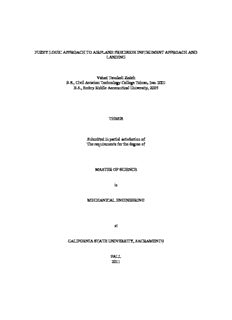
fuzzy logic approach to airplane precision instrument approach and landing PDF
Preview fuzzy logic approach to airplane precision instrument approach and landing
FUZZY LOGIC APPROACH TO AIRPLANE PRECISION INSTRUMENT APPROACH AND LANDING Vahed Tavakoli Zadeh B.S., Civil Aviation Technology College Tehran, Iran 2001 B.S., Embry Riddle Aeronautical University, 2005 THESIS Submitted in partial satisfaction of The requirements for the degree of MASTER OF SCIENCE in MECHANICAL ENGINEERING at CALIFORNIA STATE UNIVERSITY, SACRAMENTO FALL 2011 FUZZY LOGIC APPROACH TO AIRPLANE PRECISION INSTRUMENT APPROACH AND LANDING A Thesis by Vahed Tavakoli Zadeh Approved by: __________________________________, Committee Chair Akihiko Kumagai, Ph. D. __________________________________, Second Reader Tien-I Liu, Ph. D. ____________________________ Date ii Student: Vahed Tavakoli Zadeh I certify that this student has met the requirements for format contained in the University format manual, and that this thesis is suitable for shelving in the Library and credit is to be awarded for the thesis. __________________________, Graduate Coordinator ___________________ Akihiko Kumagai, Ph. D. Date Department of Mechanical Engineering iii Abstract Of FUZZY LOGIC APPROACH TO AIRPLANE PRECISION INSTRUMENT APPROACH AND LANDING By Vahed Tavakoli Zadeh In the precision instrument approach and landing of an airplane where the uncertainty is very frequent due to the high sensitivity of the activity to many factors that influence the behavior of the pilots, Fuzzy logic can be used to produce estimates which take into account the vagueness of the flight environment. In this situation, an important decision about the approach and landing of the airplane under Instrument meteorological conditions is based on these conditions. Instrument meteorological conditions (IMC) describes weather conditions that require pilots to fly primarily by reference to instruments, and therefore under Instrument Flight Rules (IFR), rather than by outside visual. Typically, instrument meteorological conditions are defined as bad visibility and low ceiling. In this thesis an analysis of the inputs under fuzzy logic approach is considered for a landing of airplane in Instrument meteorological conditions. The success rate of landing is investigated, when the visibility, pilot experience and air speed are given by a fuzzy function. The main advantages of this approach are then discussed. Precision instrument approach and landing simulations are used and the performance of the fuzzy based system is evaluated with fuzzy logic toolbox under MATLAB’s Simulation Block iv Set which provides a complete set of tools for evaluating the success rate of landing under the given inputs. Around 100 approach and landings are simulated using Microsoft Flight Simulator. All these flight simulation cases were applied to train the proposed fuzzy logic engine to calculate the success rate of landing. After the proposed fuzzy logic engine has been fully developed, it has been evaluated and then the evaluated results from the proposed fuzzy logic engine compared with flight simulation data collected for evaluation. Comparison of the results from the developed fuzzy based system and flight simulation results show that the proposed fuzzy engine can successfully predict the success rate of landing under the given inputs. _______________________, Committee Chair Akihiko Kumagai, Ph. D. _______________________ Date v ACKNOWLEDGMENTS The author would like to acknowledge and thank: the support of Department of Mechanical Engineering at California State University, Sacramento for providing the computational resources, and Dr. Akihiko Kumagai and Dr. Tien-I Liu for their technical expertise and guidance. Lastly, I would like to thank Dr Holl, Department Chair, for the help to complete my Master in Mechanical Engineering. Finally, I would like to thank my wife, Abbey, for her love, support, and encouragement that has enabled me to get this far. vi TABLE OF CONTENTS Page Acknowledgments …………………………………………………………...………………...vi List of Tables…………………………………………..………………………………………ix List of Figures ………………………………………………………………………………....x Chapter 1. INTRODUCTION …………………………. ………. …………………………………......1 2. DESCRIPTION OF THE PROPOSED FUZZY LOGIC …………………………………..5 2.1 Introduction …………………………………………………….……………………...5 2.2 The Proposed Fuzzy Inference System…….……................…………………………..9 2.2.1 Overview of Fuzzy Inference Process ……………………..……………………9 2.2.2 Step 1. Fuzzify Inputs ……………………………………………………….…10 2.2.3 Step 2. Apply Fuzzy Operator ……………………………………….………...10 2.2.4 Step 3. Apply Implication Method …………………………………….……....11 2.2.5 Step 4. Aggregate All Outputs …………………………………………………12 2.2.6 Step 5. Defuzzify ………………………………………………………………13 3. THE FIS MODLING AND SIMULATIONS ……………….……………………………14 3.1 Introduction …………………………………………………………………………..14 3.2 Modeling ……………………………………………………………………………...14 3.3 Loading Data ………………………………………………………………………....16 3.4 ANFIS Training ………………………………………………………………………20 3.5 The FIS Editor ………………………………………………………………………..22 3.6 The Membership Function Editor …………………………….……………………...23 vii 3.7 The Rule Editor ………………………………………………………………………26 3.8 The Rule Viewer ……………………………………………….……………………..27 3.9 The Surface Viewer …………………………………………….…………………….29 3.10 The FIS Evaluation ………………………………….………………………………32 4. CONCLUSION AND FURTHER STUDY ………………………………………………35 Appendix A The Matlab Structure Syntax.….………………………………………………...37 Appendix B Membership Function Plots and Surface Plot.………...………………………...41 Appendix C Flight Simulation Results…………………………………………….………….45 References ……………………………………………………………………………….……49 viii LIST OF TABLES Page 1. Table 1 The FIS and Simulation Results ……………..…………….…...……………....33 ix LIST OF FIGURES Page 1. Figure 1.1 Flight Simulation with MS Flight Simulator………………………………......3 2. Figure 2.1 A Graphical Example Of An Input-Output Map ……..…...………………......5 3. Figure 2.2 Roadmap For The Fuzzy Inference Process ……………..……………......…..6 4. Figure 2.3 Visibility Membership Function Curve ………………………………….........7 5. Figure 2.4 The Proposed Fuzzy Inference System ………..……………………...…. …..8 6. Figure 2.5 The Basic Structure of the Fuzzy Inference System ……………....……….....9 7. Figure 2.6 Visibility Input ……………………………………………………...………..10 8. Figure 2.7 Apply Fuzzy Operator AND ……………………………...……………........11 9. Figure 2.8 Apply Implication Method ………………………………...…………….......11 10. Figure 2.9 Aggregate All Outputs ……………………………………...………………..12 11. Figure 2.10 Defuzzify the Aggregated Output ………………………………………. ...13 12. Figure 3.1 The ANFIS Editor GUI Window …………………………………...……….15 13. Figure 3.2 Loading the Training Data Set …………………………………………..…..16 14. Figure 3.3 Loading the Checking Data Set ………………...……………………………17 15. Figure 3.4 The Model FIS Structure ………………………...…………………………..19 16. Figure 3.5 The Checking Error and Training Plot …………...………………………….20 17. Figure 3.6 Testing the Training Data against the FIS Output …………...………………21 18. Figure 3.7 The FIS Editor ………………………………………………..……………...22 19. Figure 3.8 Visibility Membership Functions ………………………………. ….……….23 20. Figure 3.9 Pilot Experience Membership Functions …………………………………….24 21. Figure 3.10 Air Speed Membership Function …………………………………………...25 x
Description: